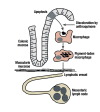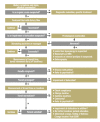The pathophysiology, diagnosis, and treatment of constipation
- PMID: 19623313
- PMCID: PMC2704368
- DOI: 10.3238/arztebl.2009.0424
The pathophysiology, diagnosis, and treatment of constipation
Abstract
Background: Constipation is a common condition about which there are many widespread notions that have no basis in fact. The purpose of this article is to summarize current scientific knowledge on the subject.
Methods: Selective review of the literature.
Results: Diagnostic evaluation usually fails to reveal the cause of constipation. It is due to medications in some patients, while endocrine disorders are the cause in only a small minority. Abnormal defecation may be due to dysfunction of the pelvic floor. Most patients complain of abdominal fullness and of needing to strain to pass stool; low stool frequency is a rare symptom. The symptoms alone determine the indication for treatment. Constipation usually poses no threat to health. Some patients are helped by a diet rich in fiber, others by laxatives. A number of laxatives with different modes of action are available; all are safe and generally well tolerated. In some patients, dysfunctional defecation may be an indication for proctological surgery.
Conclusions: The Rome criteria are useful for establishing a specific diagnosis of constipation. Most patients can be helped with laxatives and patient education.
Keywords: constipation; defecation; dietary fiber; laxatives.
Figures



Comment in
-
Correspondence (letter to the editor): obsolescence of X-ray defecography.Dtsch Arztebl Int. 2009 Nov;106(46):765; author reply 767-8. doi: 10.3238/arztebl.2009.0765a. Epub 2009 Nov 13. Dtsch Arztebl Int. 2009. PMID: 20019867 Free PMC article. No abstract available.
-
Correspondence (letter to the editor): a very welcome article.Dtsch Arztebl Int. 2009 Nov;106(46):765-6; author reply 767-8. doi: 10.3238/arztebl.2009.0765c. Epub 2009 Nov 13. Dtsch Arztebl Int. 2009. PMID: 20019868 Free PMC article. No abstract available.
-
Correspondence (letter to the editor): potential for dependence.Dtsch Arztebl Int. 2009 Nov;106(46):765; author reply 767-8. doi: 10.3238/arztebl.2009.0765b. Epub 2009 Nov 13. Dtsch Arztebl Int. 2009. PMID: 20019869 Free PMC article. No abstract available.
-
Correspondence (letter to the editor): confusion.Dtsch Arztebl Int. 2009 Nov;106(46):766-7; author reply 767-8. doi: 10.3238/arztebl.2009.0766b. Epub 2009 Nov 13. Dtsch Arztebl Int. 2009. PMID: 20019870 Free PMC article. No abstract available.
-
Correspondence (letter to the editor): an excellent article.Dtsch Arztebl Int. 2009 Nov;106(46):766; author reply 767-8. doi: 10.3238/arztebl.2009.0766a. Epub 2009 Nov 13. Dtsch Arztebl Int. 2009. PMID: 20019871 Free PMC article. No abstract available.
Similar articles
-
Constipation: Pathophysiology and Current Therapeutic Approaches.Handb Exp Pharmacol. 2017;239:59-74. doi: 10.1007/164_2016_111. Handb Exp Pharmacol. 2017. PMID: 28185025 Review.
-
An approach to the diagnosis and management of Rome IV functional disorders of chronic constipation.Expert Rev Gastroenterol Hepatol. 2020 Jan;14(1):39-46. doi: 10.1080/17474124.2020.1708718. Epub 2020 Jan 2. Expert Rev Gastroenterol Hepatol. 2020. PMID: 31893959 Review.
-
[Constipation: Initial evaluation and diagnostic approach].Rev Gastroenterol Mex. 2005 Jul-Sep;70(3):312-22. Rev Gastroenterol Mex. 2005. PMID: 17063788 Review. Spanish.
-
Cochrane Review: Osmotic and stimulant laxatives for the management of childhood constipation (Review).Evid Based Child Health. 2013 Jan;8(1):57-109. doi: 10.1002/ebch.1893. Evid Based Child Health. 2013. PMID: 23878124 Review.
-
Constipation: evaluation and treatment.Gastroenterol Clin North Am. 2003 Jun;32(2):659-83. doi: 10.1016/s0889-8553(03)00026-8. Gastroenterol Clin North Am. 2003. PMID: 12858610 Review.
Cited by
-
Novel Effects of Traditional Wooden Toothbrush on Bowel Motility Symptoms in Spinal Cord Injury Patients; Findings from a Pilot Quasi-experimental Study.Int J Prev Med. 2017 Jun 23;8:46. doi: 10.4103/ijpvm.IJPVM_174_16. eCollection 2017. Int J Prev Med. 2017. PMID: 28706615 Free PMC article.
-
Effects of dates pulp extract and palm sap (Phoenix dactylifera L.) on gastrointestinal transit activity in healthy rats.J Med Food. 2014 Jul;17(7):782-6. doi: 10.1089/jmf.2013.0112. Epub 2014 Mar 10. J Med Food. 2014. PMID: 24611963 Free PMC article.
-
Management of chronic constipation in patients with diabetes mellitus.Indian J Gastroenterol. 2017 Jan;36(1):11-22. doi: 10.1007/s12664-016-0724-2. Epub 2016 Dec 17. Indian J Gastroenterol. 2017. PMID: 27987136 Review.
-
Laxative activities of Mareya micrantha (Benth.) Müll. Arg. (Euphorbiaceae) leaf aqueous extract in rats.BMC Complement Altern Med. 2010 Feb 16;10:7. doi: 10.1186/1472-6882-10-7. BMC Complement Altern Med. 2010. PMID: 20158903 Free PMC article.
-
Diagnosis and treatment of chronic constipation--a European perspective.Neurogastroenterol Motil. 2011 Aug;23(8):697-710. doi: 10.1111/j.1365-2982.2011.01709.x. Epub 2011 May 24. Neurogastroenterol Motil. 2011. PMID: 21605282 Free PMC article. Review.
References
-
- Everhart JE, Go VLW, Johannes RS, Fitzsimmons SC, Roth HP, White LR. A longitudinal survey of self-reported bowel habits in the United States. Dig Dis Sci. 1989;34:1153–1162. - PubMed
-
- Longstreth GF, Thompson WG, Chey WD, Houghton LA, Mearin F, Spiller RC. Functional Bowel Disorders. Gastroenterology. 2006;130:1480–1491. - PubMed
-
- Müller-Lissner SA, Kamm MA, Scarpignato C, Wald A. Myths and misconceptions about chronic constipation. Amer J Gastroenterol. 2005;100:232–242. - PubMed
-
- Voderholzer WA, Schatke W, Mühldorfer BE, Klauser AG, Birkner B, Müller-Lissner SA. Clinical response to dietary fiber treatment in chronic constipation. Am J Gastroenterol. 1997;92:95–98. - PubMed
Publication types
MeSH terms
LinkOut - more resources
Full Text Sources
Medical

